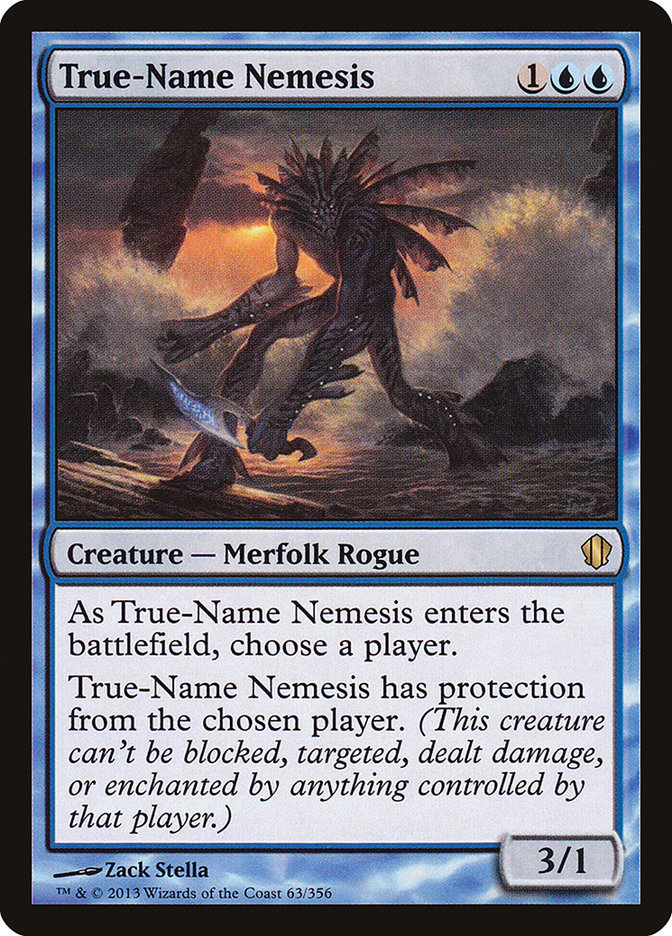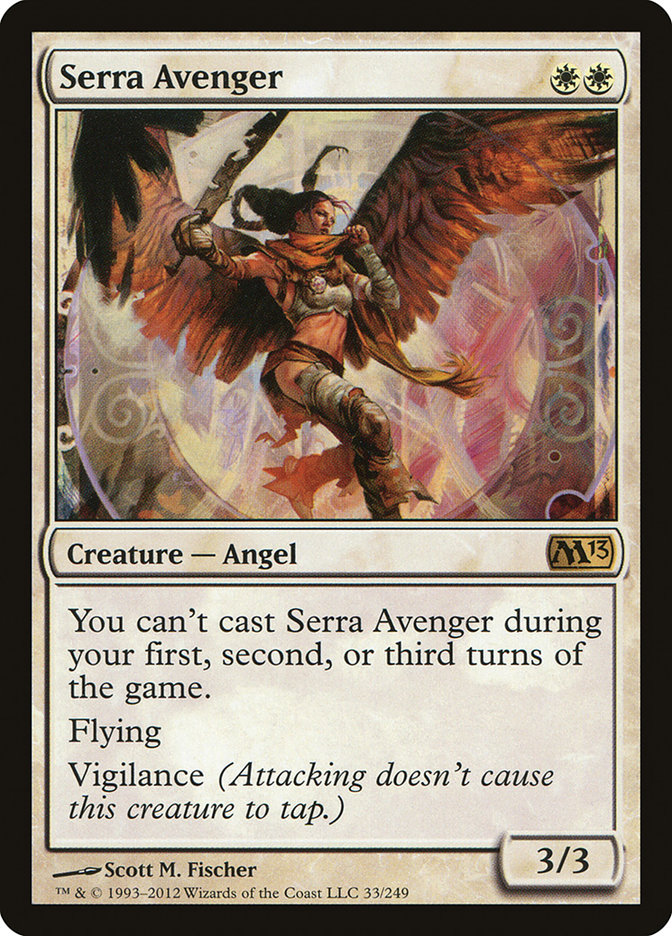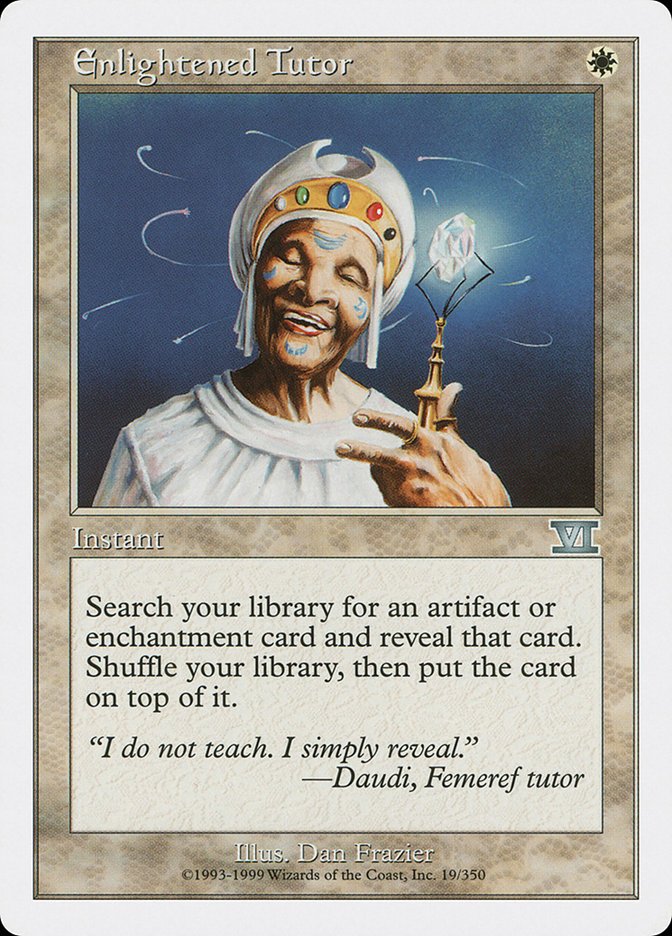Recently I decided that I really wanted to dust off my Rishadan Ports.
Between Goblins being unplayable and Lands being unbearable, that really only left me with one deck: Death and Taxes.
For those unfamiliar, Death and Taxes is yet another in a laundry list of horribly-named Legacy decks. Derived from the phrase “There’s no constant in life
except death and taxes,” it’s an homage to one of the few constant archetypes in Magic: tiny white creatures that attack the opponent.
However, classifying Death and Taxes as a White Weenie deck doesn’t really fit, at least not these days. Death and Taxes is much closer in concept to decks
like Ponza–it seeks to create a mana advantage over the opponent and exploit it with threats that can end the game before the opponent finds sure footing
and crushes you with real cards. While we’re used to linking the idea of Red with a mana denial strategy, Death and Taxes does a lot of strong work between
Rishadan Port, Thalia, Guardian of Thraben, and format staple Wasteland.
Here’s a recent sample list from a fearsome mage indeed, Dave Shiels.
Creatures (27)
- 4 Mother of Runes
- 3 Serra Avenger
- 2 Aven Mindcensor
- 3 Flickerwisp
- 4 Stoneforge Mystic
- 2 Mirran Crusader
- 4 Phyrexian Revoker
- 4 Thalia, Guardian of Thraben
- 1 Spirit of the Labyrinth
Lands (23)
Spells (10)

While Dave has made some choices that might seem a little unconventional–the singleton Spirit of the Labyrinth in the main and the Batterskull in the
sideboard–the actual seventy-five deviate very little from the newest form of the deck established during the November 2013 Bazaar of Moxen, which featured dual Top 8 appearances by Thomas
Enevoldsen and Shahar Shenhar.
I say “newest form” of the deck because it used to look a little different. For those of you not in the know, Thomas Enevoldsen is an accepted master of
the archetype and in fact wielded it to a win at Grand Prix Strausborg.
Creatures (27)
- 4 Mother of Runes
- 2 Mangara of Corondor
- 2 Aven Mindcensor
- 3 Flickerwisp
- 4 Stoneforge Mystic
- 3 Mirran Crusader
- 4 Phyrexian Revoker
- 1 Fiend Hunter
- 4 Thalia, Guardian of Thraben
Lands (23)
Spells (10)

The primary differences here are the absence of Serra Avenger and the presence of creature-based removal in Fiend Hunter and Mangara of Corondor. Clearly
that variant was working quite well for Thomas and fellow teammate/Danish idol sensation Michael Bonde, who notched a Top 8 in the same Grand Prix. So what
precipitated the change?
Now, in all fairness, Ari Lax actually managed to win the 2013 Legacy Championship
with a list very close to the GP Strausborg list, deviating mostly for Enlightened Tutor in the sideboard (more on that later). However, that event was
immediately after True-Name’s debut; players hadn’t quite figured it out just yet. It took Grand Prix Washington DC and the tournaments that followed to
prove its true home was in the Stoneblade and U/W/R Delver strategies, which could both use him to clog up the ground before presenting an Umezawa’s Jitte
or Batterskull to create an often unbeatable combination for creature decks like Death and Taxes.
The problem was compounded by the fact that many players were turning to cards like Golgari Charm and Zealous Persecution to solve their own True-Name
Nemesis problems, offering them a ton of post-sideboard game against Death and Taxes whether they wanted it or not.
So, how do you solve an untouchable ground-pounder? Why, you take to the skies!
The Avengers provide a pretty serious clock and survive a lot of the most popular hate, such as the aforementioned -1/-1 effects, Dread of Night, and
Massacre. They can also trade with threats like Nimble Mongoose and Delver of Secrets when necessary and operate not unlike a vigilant True-Name Nemesis in
conjunction with Mother of Runes or even the occasional Aether Vial on three counters with a Flickerwisp in the hand.
Being able to win these races in the air is important once you cut Mangara of Corondor, because the former inmate of Amber Prison created significant
inevitability in conjunction with Karakas and an Aether Vial, enabling you to eventually exile all relevant opposing permanents. A primary problem with a
mana denial strategy can be beating the opponent once they advance through your mana denial–Mangara ensured that would never happen. Without Mangara, you
need to present a much more significant or measured offense in order to win the game in the window you create.
Few lists deviated from this plan in the months that followed–and why would they, with luminaries like Shiels, Shenhar, and father Enevoldsen at their
back? However, just a few months ago we saw a significantly different take on Death and Taxes make it to the Top 8 of another Bazaar of Moxen in the hands
of Wenzel Krautmann.
Creatures (25)
- 3 Mother of Runes
- 2 Mangara of Corondor
- 2 Aven Mindcensor
- 2 Stoneforge Mystic
- 4 Leonin Arbiter
- 4 Phyrexian Revoker
- 4 Thalia, Guardian of Thraben
- 4 Spirit of the Labyrinth
Lands (17)
Spells (18)

This deck first popped up on MTGO in the hands of dredgemundo, and I haven’t really seen heads or tails of it since. What’s going on is pretty interesting;
rather than attempt to race, it returns to the lockdown game with Mangara of Corondor and adds a playset of Leonin Arbiter and Ghost Quarters to the
industry standard pair of Aven Mindcensors. With this level of mana denial, it’s feasible to prevent the majority of True-Name players from casting the
card at all. Even Deathrite Shaman is of limited utility because most Shaman-fueled decks are packed with fetchlands to enhance their all-star one-drop,
and the presence of Thalia and Mother of Runes essentially blank Abrupt Decay as a solution to the 2/2’s intense mana choke-hold.
Worth noting is that Ghost Quarter can attack basic lands, which many players will search for against you to avoid getting Wastelanded. This punishes them
doubly, as they may not have basics available when you Ghost Quarter them later, Arbiter or no.
Death and Taxes plays one very significant shuffle effect of its own in Stoneforge Mystic, and in this list the powerful Squire has been trimmed to
ameliorate the occurrence of that particular nonbo. Worth it? Well, that’s the question, right?
And dredgemundo didn’t stop there. The other major change was the introduction of four Spirit of the Labyrinths, a card that’s not very good at battling
past True-Names and Tarmogoyf but that can obliterate opponents trying to use cantrips to dig through your copious mana denial. Against many decks Ghost
Quarter is a Wasteland whether or not you have an Arbiter, and being unable to effectively Brainstorm or Ponder through the deck is a huge problem. Heaven
forbid you live the dream and get to Vial it in response to a Brainstorm! And of course, when you’re playing against opponents that lack those big fatties
on the ground–like Miracles and virtually any combo deck in the format–the Spirit’s effect is often a freeroll in comparison to Serra Avenger.
A fair note here is that with the loss of so many flying creatures and the reduction of Swords to Plowshares and trim of Batterskull, a turn 1 (or 2 or 3)
Delver of Secrets became much, much scarier than it might have been otherwise. This I disliked.
So, I went into my own brewery with all of these ideas floating in my head. First, I just played Shiels’ list in a local Legacy event to get a feel for it
and try to understand all of the potential trade offs. I took a predictable loss to Elves, although I punted a game 1 win by incorrectly evaluating the
race based on the belief that I could avoid a Natural Order one turn longer than I actually could. I learned a lot and became pretty dissatisfied with some
elements, namely Flickerwisp.
I started playing with the dredgemundo list next. Predictably, I enjoyed a vastly superior Miracles matchup, and my Elves matchup had also
improved–Arbiter is a nice card against Zenith and Natural Order, and Spirit can limit their potential to abuse Glimpse and Elvish Visionary. However, the
matchup was still horrible because my creatures couldn’t actually get through before they eventually amassed enough stuff to kill me, and my own list in
fact made Jitte more difficult to assemble.
I didn’t take the time to add Council’s Judgment first–I don’t like to tinker before I’ve tried–but I think it’s plausible that this card could solve
some of the issues. I’m not super-excited about that plan, because you can’t afford to run a lot of copies and you have zero library manipulation to dig
for it, but the card is certainly good and should be considered.
I decided to try mixing a little chocolate with my peanut butter, and registered this list at my next event:
Creatures (25)
- 4 Mother of Runes
- 4 Serra Avenger
- 1 Aven Mindcensor
- 3 Stoneforge Mystic
- 4 Leonin Arbiter
- 4 Phyrexian Revoker
- 4 Thalia, Guardian of Thraben
- 1 Spirit of the Labyrinth
Lands (14)
Spells (21)

You’ll note a few odd things here. The bullet Spirit I stole from Dave–yes, I’m addicted to a good mise. I also cut a Karakas and the Horizon Canopy
because I wanted to ensure I had a few more basics; with only fourteen white sources, I was operating a little below typical lists and wanted to ensure
Wasteland could rarely deprive me of the ability to cast my spells with Aether Vial absent, a factor that mattered a lot after they sideboarded in
solutions to Vial. The Canopy hadn’t been very relevant for me, and Karakas was often a freeroll but not especially important in the metagame I was playing
(very few gigantic legends).
In the sideboard, I opted to split Cataclysm against Armageddon in the hopes of convincing myself which one was better; I’m still not actually sure and
would be interested to hear arguments either way. The ability to kill Jace against Miracles never felt like it actually mattered, because I never lost
after resolving either spell.
I wanted to have that solid core of flying creatures to help me close out games and to enable trades with Delver of Secrets when necessary. I felt like a
big favorite against most Delver decks if I could save my Swords for Tarmogoyf or Deathrite Shamans. The deck was noticeably stronger against -1/-1
effects, because I had a ton of creatures that would survive one and the ability to strip them off the mana to cast one before deploying my more vulnerable
creatures.
This deck also had the relatively unique ability to play its game with Vial on two alone, which was nice. The Flickerwisps and Mirran Crusaders pay off the
most with Vial on three, but in doing so you had to cast your two-drops, a fact that could often matter if you were blasting their lands or facing an early
Counterbalance. There are pros and cons, but I found the idea attractive enough.
Did I like this list? No, not really. I lost a round to BUG Delver because I never found a second Plains in game 3 to lock it up once my Vials had been
Needled (20/20 foresight sometimes isn’t good enough!) and then took yet another beatdown from Elves in which I felt approximately as powerless as before.
It might just be a dismal showing talking here, but I essentially felt like I’d traded a lot of my offensive away for the mana denial, and I was now
playing long games with a beatdown deck. Without something like Brainstorm to refuel, I was getting into nonstop trouble.
On the upside, I went 7-0 against various Miracles lists with this version, which was somewhat pleasing. If your metagame is infested with Miracles and
combo, I think this is a pretty reasonable list; losing out on Flickerwisp’s ability to spin races against Tarmogoyf decks definitely stung me though, and
Mirran Crusader is at an all-time high right now in the format so that sacrifice is likely not worthwhile. I think a better route would be something like
Wenzel’s decklist, but sideboard essentially nothing against Miracles in order to shore up these matchups.
For now, I’ll continue to recommend something along the lines of the Shiels list. I’d like to keep exploring Leonin Arbiter because the payoffs are
attractive. After all, most games of Magic are perilously easy to win when your opponent can’t cast any spells, even if that means getting Grizzly.
I’m also going to keep thinking about how to beat Elves. It’s a horrible matchup and reasonably popular, but considering everyone else seems to be able to
beat it a fair bit of the time it shouldn’t really be that hard to come up with some kind of plan! Splashing for Zealous Persecution is an option as long
as you don’t run Leonin Arbiter, and there are hate cards like Cursed Totem available if you decide you want to crush somebody. It’s most likely not worth
it–you should just accept the bad matchup and move on with your life–but I can’t help thinking that where there’s a will, there’s a way.
I’d like to conclude with one last bone of contention in lists: the Enlightened Tutor package.
As you’ve likely noticed, these sideboards are packed with artifacts and enchantments. I’ve been a big fan of sideboards like the one Ari Lax employed in
my Maverick decks before, but I’m very wary of it here. One of the interactions I like the most is being able to Enlightened Tutor for an Oblivion Ring and
pop Horizon Canopy for it in response to Show and Tell, but with a singleton of the land and no way to find it, that would be a rarity here. Ari accounted
for this by running an additional copy, but I perceive this as a drop in the well.
Tutor is card disadvantage, so whatever you’re finding really needs to end the game against your opponent, and few cards do that convincingly. Even Cursed
Totem can often be a temporary solution against Elves, because they have the ability to tutor for Reclamation Sage and frequently side in Abrupt Decays
against you.
Amusingly, Leonin Arbiter is pretty great at protecting Cursed Totem in this matchup… but that plan is obviously flawed considering that the Tutor itself
is a nonbo with Arbiter. You can curve Tutor into Arbiter into Cursed Totem, but it’s entirely possible you’ll be dead (or functionally dead) at that point
anyway, which is disappointing.
I’m enjoying my foray into this archetype, as every game is fun and decision-intensive. My personal “rules for Legacy” are 1) play basic lands or Deathrite
Shaman and 2) be proactive, so this deck fits the bill for me quite well. I’m not a big fan of pure combo decks and Stifling people has gotten pretty dull,
so I imagine you’ll see me with basic Plains in the deckbox for quite some time!




